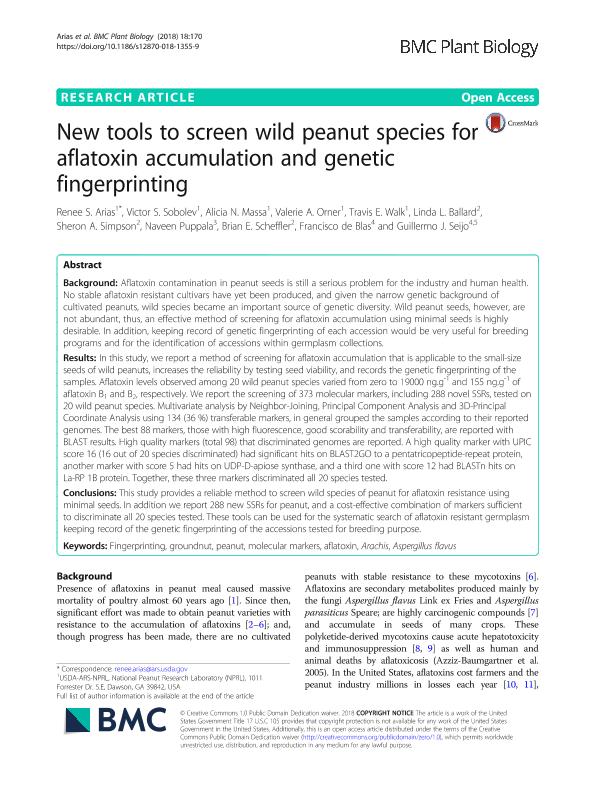Mostrar el registro sencillo del ítem
dc.contributor.author
Arias, Renee S.
dc.contributor.author
Sobolev, Victor S.
dc.contributor.author
Massa, Alicia N.
dc.contributor.author
Orner, Valerie A.
dc.contributor.author
Walk, Travis E.
dc.contributor.author
Ballard, Linda L.
dc.contributor.author
Simpson, Sheron A.
dc.contributor.author
Puppala, Naveen
dc.contributor.author
Scheffler, Brian E.
dc.contributor.author
de Blas, Francisco Javier

dc.contributor.author
Seijo, José Guillermo

dc.date.available
2019-08-02T14:12:11Z
dc.date.issued
2018-08
dc.identifier.citation
Arias, Renee S.; Sobolev, Victor S.; Massa, Alicia N.; Orner, Valerie A.; Walk, Travis E.; et al.; New tools to screen wild peanut species for aflatoxin accumulation and genetic fingerprinting; BioMed Central; BMC Plant Biology; 18; 1; 8-2018; 1-13
dc.identifier.uri
http://hdl.handle.net/11336/80794
dc.description.abstract
Aflatoxin contamination in peanut seeds is still a serious problem for the industry and human health. No stable aflatoxin resistant cultivars have yet been produced, and given the narrow genetic background of cultivated peanuts, wild species became an important source of genetic diversity. Wild peanut seeds, however, are not abundant, thus, an effective method of screening for aflatoxin accumulation using minimal seeds is highly desirable. In addition, keeping record of genetic fingerprinting of each accession would be very useful for breeding programs and for the identification of accessions within germplasm collections. Results: In this study, we report a method of screening for aflatoxin accumulation that is applicable to the small-size seeds of wild peanuts, increases the reliability by testing seed viability, and records the genetic fingerprinting of the samples. Aflatoxin levels observed among 20 wild peanut species varied from zero to 19000 ng.g-1 and 155 ng.g-1 of aflatoxin B1 and B2, respectively. We report the screening of 373 molecular markers, including 288 novel SSRs, tested on 20 wild peanut species. Multivariate analysis by Neighbor-Joining, Principal Component Analysis and 3D-Principal Coordinate Analysis using 134 (36 %) transferable markers, in general grouped the samples according to their reported genomes. The best 88 markers, those with high fluorescence, good scorability and transferability, are reported with BLAST results. High quality markers (total 98) that discriminated genomes are reported. A high quality marker with UPIC score 16 (16 out of 20 species discriminated) had significant hits on BLAST2GO to a pentatricopeptide-repeat protein, another marker with score 5 had hits on UDP-D-apiose synthase, and a third one with score 12 had BLASTn hits on La-RP 1B protein. Together, these three markers discriminated all 20 species tested. Conclusions: This study provides a reliable method to screen wild species of peanut for aflatoxin resistance using minimal seeds. In addition we report 288 new SSRs for peanut, and a cost-effective combination of markers sufficient to discriminate all 20 species tested. These tools can be used for the systematic search of aflatoxin resistant germplasm keeping record of the genetic fingerprinting of the accessions tested for breeding purpose.
dc.format
application/pdf
dc.language.iso
eng
dc.publisher
BioMed Central

dc.rights
info:eu-repo/semantics/openAccess
dc.rights.uri
https://creativecommons.org/licenses/by-nc-sa/2.5/ar/
dc.subject
Aflatoxin
dc.subject
Arachis
dc.subject
Aspergillus Flavus
dc.subject
Fingerprinting
dc.subject
Groundnut
dc.subject
Molecular Markers
dc.subject
Peanut
dc.subject.classification
Nutrición, Dietética

dc.subject.classification
Ciencias de la Salud

dc.subject.classification
CIENCIAS MÉDICAS Y DE LA SALUD

dc.title
New tools to screen wild peanut species for aflatoxin accumulation and genetic fingerprinting
dc.type
info:eu-repo/semantics/article
dc.type
info:ar-repo/semantics/artículo
dc.type
info:eu-repo/semantics/publishedVersion
dc.date.updated
2019-08-01T21:51:46Z
dc.identifier.eissn
1471-2229
dc.journal.volume
18
dc.journal.number
1
dc.journal.pagination
1-13
dc.journal.pais
Reino Unido

dc.description.fil
Fil: Arias, Renee S.. National Peanut Research Laboratory; Estados Unidos
dc.description.fil
Fil: Sobolev, Victor S.. National Peanut Research Laboratory; Estados Unidos
dc.description.fil
Fil: Massa, Alicia N.. National Peanut Research Laboratory; Estados Unidos
dc.description.fil
Fil: Orner, Valerie A.. National Peanut Research Laboratory; Estados Unidos
dc.description.fil
Fil: Walk, Travis E.. National Peanut Research Laboratory; Estados Unidos
dc.description.fil
Fil: Ballard, Linda L.. Usda Agricultural Research Service; Estados Unidos
dc.description.fil
Fil: Simpson, Sheron A.. Usda Agricultural Research Service; Estados Unidos
dc.description.fil
Fil: Puppala, Naveen. New Mexico State University Las Cruces; México
dc.description.fil
Fil: Scheffler, Brian E.. Usda Agricultural Research Service; Estados Unidos
dc.description.fil
Fil: de Blas, Francisco Javier. Consejo Nacional de Investigaciones Científicas y Técnicas. Centro Científico Tecnológico Conicet - Córdoba. Instituto Multidisciplinario de Biología Vegetal. Universidad Nacional de Córdoba. Facultad de Ciencias Exactas Físicas y Naturales. Instituto Multidisciplinario de Biología Vegetal; Argentina
dc.description.fil
Fil: Seijo, José Guillermo. Consejo Nacional de Investigaciones Científicas y Técnicas. Centro Científico Tecnológico Conicet - Nordeste. Instituto de Botánica del Nordeste. Universidad Nacional del Nordeste. Facultad de Ciencias Agrarias. Instituto de Botánica del Nordeste; Argentina
dc.journal.title
BMC Plant Biology

dc.relation.alternativeid
info:eu-repo/semantics/altIdentifier/url/https://bmcplantbiol.biomedcentral.com/articles/10.1186/s12870-018-1355-9
dc.relation.alternativeid
info:eu-repo/semantics/altIdentifier/doi/https://dx.doi.org/10.1186%2Fs12870-018-1355-9
Archivos asociados
